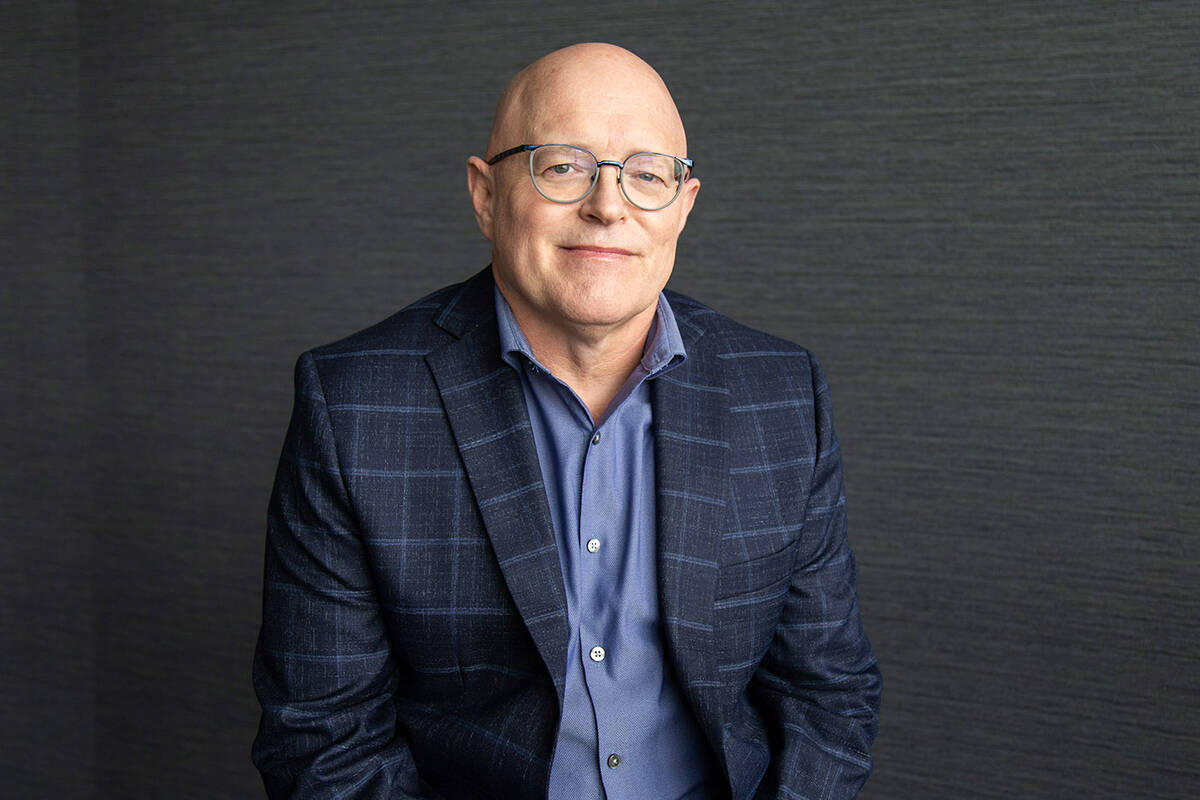The Southern Nevada landscape for digital infrastructure is changing rapidly, and the region is trying to meet this surging demand for data centers while balancing the challenges around power and water.
That was the topic at last week’s monthly breakfast meeting of the Southern Nevada chapter of NAIOP. The meeting at The Orleans drew nearly 400 people.
Moderated by Brent Nasset, a site development consultant for Kimley-Horn and president of the Northern Nevada chapter of NAIOP, the panel included Steve Boyce, vice president of mission critical for Novva Data Centers; Jeff Brigger, director of business development and major accounts for NV Energy; Steve Roberts, vice president of development for Switch; and Colby Pellegrino, deputy general manager for resources for the Southern Nevada Water Authority.
“The data center industry across the country is exploding, but the economy is slow,” Nasset said. “Nationally, the economy is growing at a 0.3 percent growth rate year over year. If you look at the investment in data centers, if that wasn’t there, it’s likely our country would be in a recession. There’s a lot of challenges with data centers but also a tremendous amount of opportunity.”
Data centers were once largely in Silicon Valley and some were in Virginia but in the last couple of years the algorithm for data centers has changed. It goes where power is available, and they’re seeing data centers in every corner of the market and every state, Nasset said.
“There’s a lot of discussion happening across the country right now, and unfortunately a lot of those discussions are happening in silos,” Nasset said. “There are a lot of corners of the room that aren’t talking to each other, and I think that what makes NAIOP great and what makes Nevada great is that this is a market where we talk to each other. We talk about what it means for the community and folks involved in construction and what does it mean for people living there. We’re all trying to figure out how to manage this, and manage the communication, and what it means for data center development in Nevada.”
A data center can be 100 times more energy intensive than a normal commercial building. In 2022, there was four gigawatts of data centers brought online and between 2025 and 2030 it could range from 100 gigawatts to 400 gigawatts.
“We’re seeing a crazy amount of growth, and that’s exposing a lot of challenges,” Nasset said.
Boyce said Novva is a 6-year-old company and has not seen the marketplace like it is today. When they were planning, they were looking at data storage for companies such as Tesla, but two years later they leased their entire building overnight.
“We never anticipated that,” Boyce said. “We expected to have that happen over a five-year-to-eight-year period based on previous experience. It’s an example of how you can’t predict the future based on historical trends. The other thing that happened in unison was the density of everything. You have to be innovative. You can’t stick to this is how we’ve done it. Sometimes, you have to throw everything away while you’re in the middle of it.”
Boyce said the development community hates that they get a set of drawings only to be changed. Those who can adapt are most valuable.
Roberts talked about Switch as a technology infrastructure company founded in 2000 and home grown in Las Vegas with campuses around the country in Reno; Grand Rapids, Michigan; Atlanta; and Austin, Texas.
“The density and hockey-stick growth you have seen in the last two to three years alone is unparalleled,” Roberts said. “Even though we’re seasoned, we’re needing to rapidly innovate to meet the demands of the market. It’s very difficult to do so.”
Their legacy building along the 215 Beltway between Decatur and Jones boulevards had a server rack averaging about 15 kilowatts per cabinet and now the demand is 150 kilowatts or more, Roberts said.
“We’ve had to change our design and start over from scratch to design a liquid cooling solution to cater to that,” Roberts said. “Our latest design under construction can support up to two megawatts per cabinet. The scale is off the charts. We’re rapidly innovating to meet the demands of the market.”
Boyce said Nevada has its own challenges, which is heat. They have to figure out how to get the heat out of the building, requiring chillers that can operate in a higher ambient temperature. In some cases they have to work with vendors to design chillers for this area.
“The biggest challenge is the heat, water and power,” Boyce said. “Hopefully, with new legislation coming along the Bureau of Land Management can get out of the way and help us get power and some of the things we are working on.”
Roberts said Nevada has its advantages. The soils are great for building, and developers can build year-round because of the lack of rain.
“We like to build the first one-of-its-kind here because we have the most control over it,” Roberts said. “The grid is really reliable. In the seven years I’ve been here, there’s only one instance in which we had to run our generators, and that was a transformer issue. It wasn’t grid-related.”
The proximity to California is important as well, Roberts said. He said as small a market Nevada is, nationally, its fiber optic backbone is unparalleled.
Pellegrino said Nevada gets 1.8 percent of the water on the Colorado River, and the federal government has the authority to limit usage by two thirds of what is used today.
“We need to be as water-conscious as we can, and find ways to diversify our economy and continue to grow and do so with the smallest water footprint, as reasonably as we can. There’s certain things that just don’t make sense here in the Las Vegas Valley. We have done a good job of blocking some of those out, but some of what helps us hurts us. A lot of the big water-users court us because we have a national recognition for how we manage our water resources.”
Pellegrino said she’s sat with three bottling companies, who wanted to come to Las Vegas, but had to say no because they were interested in selling their products in California.
“We have been working the past three to five years on what new water uses we need to say no to and what new technology we can help bring to bear to reduce the footprint of the existing community without changing our quality of life,” Pellegrino said.
Brigger said they never intended to build extra capacity for data center usage, but it benefits that industry that they are doing so. Its Greenlink West transmission line is planned to be in service in 2027 will run about 350 miles from the Las Vegas Valley to Yerington and aims to increase Nevada’s transmission capacity for clean energy.
“The line will have a $690-million economic impact throughout the state and create 4,000 well-paying jobs to build and untap 5,000 megawatts of renewable energy that is otherwise transmission-constrained throughout our state,” Brigger said. “It’s a great investment for the state of Nevada and a great investment to continue, not only to serve a growing (energy) load in the state, and also our reliability as we can start using resources more effectively between the north and south and tap into that renewable energy. A lot of data centers we are negotiating with want that type of energy supply, and we’ve been very creative in our approaches to do so.”
NV Energy has built renewable energy to serve Google and Allegiant Stadium and it is 100 percent renewable, Brigger said.
Three to five years ago, data center customers wanted a facility for 100 megawatts, and now customers have 1,000 megawatts, which relates to the density they are seeing.
“What we are doing now to protect our existing customers, is we’re working on agreements where the network upgrades we build benefit everybody as we build out for these types of projects that will be paid for by the customer at 100 percent,” Brigger said. “That protects us and our existing customers to ensure those investments will be used to the fullest extent for what we build them for — the transmission and distribution networks that we will build — that’s what carries the capacity.”
Customers will need to sign long-term commitments because Brigger said they will need to build power generation.













